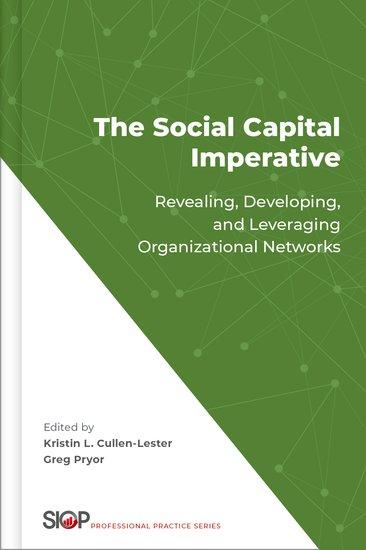
Zustellung: Di, 19.08. - Do, 21.08.
Noch nicht erschienen
VersandkostenfreiBestellen & in Filiale abholen:
Social capital, the resources and goodwill of network contacts, can be activated to enhance employees' performance, leadership effectiveness, careers, and overall organizational functioning. This book provides clearer links between insights, actions, and outcomes practitioners can expect when revealing, developing, and leveraging organizational networks. The opening section provides readers with a strong scientific grounding explaining why networks are important for each application area and the likely implications of revealing, developing, and leveraging networks. The remainder of the book provides inspiration and opportunities to learn from real-life experiences, challenges faced, actions taken, and lessons learned from applying network science within organizations.
Inhaltsverzeichnis
- Foreword
- List of Contributors
- Part l Opening
- 1: Kristin L. Cullen-Lester; Greg Pryor: The Social Capital Imperative
- Part II Network Foundations
- 2: Cé cile Emery; Daniel S. Halgin; Zexi (Flavia) Li; Xiwen Zhao: Essential Concepts and Measures in Organizational Network Analysis
- 3: Scott Hines: Conducting Network Analysis to Deliver Organizational Insights
- 4: Nicolas Petit: Tips and Traps When Conducting Network Analysis in Practice
- Part III Workforce Well-Being
- 5: Michelle Mahdon; Alexandra Gerbasi: The Influence of Networks on Workers' Well-Being
- 6: Cody Martin; Michael Hoffman; Clint Kofford: Mitigating Collaboration Overload to Improve Workforce Well-Being at Johnson and Johnson
- Part IV Career Management
- 7: Caitlin M. Porter; Ashley H. Pearson: Networks as a Source of Competitive Career Advantage
- 8: Donna Chrobot-Mason; Ali O'Malley: Combining Networks and Coaching to Spur Professional Development and Change
- 9: Deb Zehner; Greg Pryor: Accelerating New Hire Networks
- Part V Human Resources
- 10: Patrick Downes: Advancing Human Resources Practice by Adopting a Social Network Perspective
- 11: Phil Willburn; Curtis Hampton: How Workday Scaled and Sustained a Culture of Connection
- 12: Andras Vicsek: Bridging Cultures Through Influencers in Postacquisition Integration
- Part VI Creativity and Innovation
- 13: Travis J. Grosser; Ziyue Cui: Network Drivers of Employee Innovation
- 14: Michael Arena: Strategies for Creating Adaptive Space to Support Innovation at General Motors
- Part VII Teams and Team Systems
- 15: Cynthia Maupin; Semin Park: Managing Internal and External Networks for Team Effectiveness
- 16: Victor Bilgen; Chris Gideon; Neha Parikh Shah: Strategically Building Network Connections Across Geographic Markets to Improve Sales Agility and Enhance Organizational Growth
- 17: Lauren Blackwell Landon: Emergency Response Coordination in Space
- PART VIII Knowledge Sharing
- 18: Andrew Parker; Julia Brennecke: Knowledge Networks in Organizations
- 19: Katelyn Cavanaugh; Eric Middleton; Matthew Berkheiser: Removing Knowledge-Sharing Barriers at the University of Texas MD Anderson Cancer Center
- PART IX Organizational Change and Transformation
- 20: James M. Vardaman; Feigu Zhou: Social Networks and Organizational Change Implementation
- 21: Hemerson Paes: How Roche Pharma International Unlocked Cross-Boundary Collaboration at Scale
- 22: Theresa Floyd; Giuseppe (Joe) Labianca; Brad Patrick: Crowdsourcing Organizational Structure Through Social Network Analysis
- Part X Leadership Effectiveness
- 23: Caton Weinberger; Laura Bauer; Dorothy Carter: The Role of Networks in Leadership Effectiveness
- 24: Michael Campbell: Designing the Science of Networks into Leadership Development at Workday
- Part XI Diversity, Equity, and Inclusion
- 25: Juan Du; Meredith Woehler; Kristin L. Cullen-Lester: Engaging Employee Networks to Promote Workforce Diversity and Inclusion
- 26: Patrick Decker-Tonnesen; Deb Zehner; Anjali Bhagra: Mayo Clinic's Exploration of Barriers to Women in Leadership
- Part XII Closing
- 27: Greg Pryor; Kristin L. Cullen-Lester: How to Reveal, Develop, and Leverage Networks for Greater Impact
- Index
Produktdetails
Erscheinungsdatum
19. August 2025
Sprache
englisch
Seitenanzahl
744
Herausgegeben von
Kristin L. Cullen-Lester, Greg Pryor
Verlag/Hersteller
Produktart
gebunden
Gewicht
1140 g
Größe (L/B/H)
44/156/235 mm
ISBN
9780197755396
Entdecken Sie mehr
Bewertungen
0 Bewertungen
Es wurden noch keine Bewertungen abgegeben. Schreiben Sie die erste Bewertung zu "The Social Capital Imperative" und helfen Sie damit anderen bei der Kaufentscheidung.









